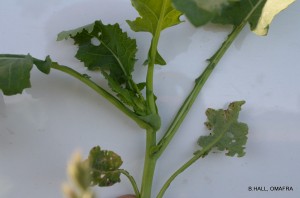
Our trap counts of adult swede midge this week have spiked to high levels in some areas. To view a map indicating swede midge trap catches go to Ontario Canola Grower’s website at www.ontariocanolagrowers.ca.
Regularly check this website for updates on the level of swede midge in your growing area until your canola is beyond the vulnerable stage. While this map may not be indication of populations for your field, they do give an idea of when population peaks are occurring. Canola fields at the greatest risk of damage will be those in traditional canola growing areas that are in relatively close proximity to fields where canola was grown in the past. Midge can overwinter in the soil for more than one season, emerge and migrate to nearby canola. Although swede midges are not strong fliers, they can also be moved on wind currents. The vulnerable stage for canola is prior to flowering. Heat and rain triggers Swede midge emergence. At this time we don’t have established economic thresholds or optimum control strategies.
However it is suggested that if swede midge populations are at the 25+ level (orange or red on map) during the canola’s most vulnerable growth stages (before flowering) a treatment spray is likely warranted, but at other times of growth higher numbers may be tolerated. Many fields are in late rosette stage to bolting and still at very vulnerable stage for damage. It will be important to properly time any spray to protect canola prior to seeing significant damage. The adult midges only live for a few days(1-5 days), lay eggs typically in the growing point where the larvae mine into the growing point causing damage. Larvae complete their life cycle in 7-21 day. There are 4-5 generations of midge per year, with overlapping emergence times. In later planted fields which are in early rosette stage, a second application may be required to protect canola through the vulnerable stages.
The two approved products for treatment of swede midge in canola are Matador and Coragen. Matador is most effective on the adults, while Coragen is most effective on the larvae and egg stages. Early application is important for protection and for the best results. Coragen appears to offer a somewhat extended residual effect (1 to 2 weeks).
Coragen is not systemic, and will not protect growth that develops subsequent to application, but it will move through the leaf to protect both leaf surfaces. Coverage is the most important point with both Matador and Coragen especially targeting growing points where the midge lay their eggs and larvae develop. Spraying larger plants means that more surface area needs to be protected, including buds that develop in leaf axis. Therefore, at more advanced crop stages, higher water volume may be necessary to achieve good coverage. A maximum of 3 applications of Matador/Silencer are permitted per season. This should be considered if you have sprayed for flea beetles and may need to control cabbage seedpod weevil later at flowering (The first flowering fields in an area will be attractive to seedpod weevil). Once flowering on secondary/tertiary branches is initiated there is no further risk of swede midge damage.
Please remember when applying an insecticide to wear appropriate protective wear and follow bee safety guidelines. To reduce risk of pesticide resistance, rotate between chemical groups.
The Ontario Canola Growers, OMAF and MRA and the University of Guelph are working together to monitor swede midge this season.